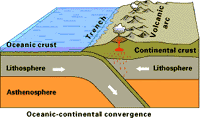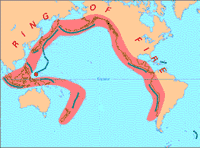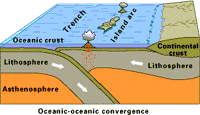
 by Andrew Logan by Andrew Logan
Kamchatka was born of fire, like the Earth itself. For most of the Earth, though, the violence of creation ended long ago. Kamchatka has never seen quiet -- its history is one of continuous, violent rebirth.
The native peoples of Kamchatka are intimately familiar with this history. They have always feared the peninsula's volcanoes, whose peaks they believed to be inhabited by mountain spirits known as gomuls. By night, the gomuls took to the sky and hunted whales, returning home with leviathans impaled on each finger. They would then roast the whales. This is why the volcanoes lit up at night. The natives believed that great heaps of whalebone lay on the mountaintops, but were too fearful to ascend the volcanoes and find out for themselves if this were true.
As someone who has experienced the awesome destructive power of volcanism, this fear is understandable to me. During my time on Kamchatka, I studied Karymsky Lake, an isolated body of water filling the caldera of what was thought to be an extinct volcano. On New Year's Eve 1996, however, a spectacular eruption burst from the lake floor. An ecological catastrophe ensued. The force of the eruption created tsunami waves 30 feet in height that leveled the forest surrounding the lake. The water in the lake became extremely acidic; all life in the lake, other than the simplest algae and bacteria, was destroyed in a matter of minutes.
For all their destructive power, volcanoes are vital to man's existence. Volcanic gases helped create earth's atmosphere, and continue to affect its composition today. On a more prosaic level, volcanic glass (obsidian) was used by ancient humans to make tools. Volcanic ash serves as a fertilizer, returning important nutrients and minerals to the soil. The city of Petropavlovsk, the main settlement on Kamchatka, is built of concrete made from cinder of the 1945 eruption of nearby Avachinsky Volcano, which watches over the city from its post 20km to the north.
 Kamchatka's Place in World Volcanism Kamchatka's Place in World Volcanism
The Kamchatka Peninsula is the northern link in the 2000 km Kuril-Kamchatka island arc. This region contains 68 active volcanoes, over 10 percent of the total found on land anywhere on Earth. This arc is part of the "Ring of Fire," a string of volcanoes that encircles the Pacific Ocean.
The existence of the Ring of Fire is explained by the theory of plate tectonics. According to this theory, Earth's surface is fractured into a number of rigid plates that move in slow motion. (The fastest plates move only a few inches per year, or about as fast as your fingernails grow.) The Ring of Fire is formed where the Pacific Plate collides with other tectonic plates.
 The Pacific Plate slides beneath these other plates, plunging into the earth at a steep angle. As the Pacific Plate sinks into the hot interior of the earth, melting occurs. The resulting magma migrates to the surface, where it eventually bursts through the crust in the form of a volcano. The Pacific Plate slides beneath these other plates, plunging into the earth at a steep angle. As the Pacific Plate sinks into the hot interior of the earth, melting occurs. The resulting magma migrates to the surface, where it eventually bursts through the crust in the form of a volcano.
A Violent Beginning: Kamchatka's Early History The history of the Kamchatka peninsula is a record of the struggle between the constructive forces of volcanism and the destructive power of the ocean. It is a history of continuous, violent change.
From Ocean Floor to Island Chain Until the late Pliocene (~2.5 million years ago), what is now Kamchatka was little more than a pool of magma waiting beneath the floor of the Pacific Ocean. When this magma finally erupted through the ocean floor, it formed submarine mountain ranges. These eventually grew tall enough to reach the ocean surface, where they formed an island chain much like the Aleutian Islands of today. Eventually this volcanic activity slowed, and as the Pleistocene epoch dawned, the balance of power was put back in the hands of the Pacific. Waves washed over Kamchatka, leveling its relief.
 Joining Up With Asia Joining Up With Asia
New basaltic flood eruptions eventually brought Kamchatka back above the sea, forming vast volcanic plateaus that connected the islands into a single landmass linked to Asia. A period of relative peace followed. A visitor to Kamchatka at the time would have found a steaming, hilly landscape resembling present-day Iceland. A thick forest graced the land surface. Glacier shields capped quiet summits, and glacial tongues extended into the sea.
An alert observer would have suspected that this calm was only temporary. Kamchatka's plateaus swelled with the pressure of gas-saturated magma, struggling to break loose. When water reached the magma through giant fissures in the earth, a great explosion shook the land, ejecting boiling magma onto the surface.
The new round of eruptions released vast floods of lava and ash, leveling the mountainous landscape and turning Kamchatka into a dull gray flatland. Hot lava domes and spines rose over the plateau, disappearing into clouds of poisonous gas.
Today's Landscape is Born As the huge magma reservoirs emptied, the Earth's surface began to sink, forming giant depressions. This gave birth to the peninsula's present landscape, where deep rift valleys cut between mountain ridges and plateaus.
Today's volcanism is a repeat, on a smaller scale, of these early Quaternary events. Modern volcanoes are located atop the rifts that fed early volcanic belts, but cover smaller areas and are more moderate in their eruptive powers.
Nevertheless, the volcanic power of Kamchatka's 29 active volcanoes is still spectacular. Kamchatka's volcanic spine includes Kluchevskoy Volcano, the largest active volcano in Eurasia and one of the largest in the world. It is nearly 5,000 m in height, with 35 times the average productivity of a land volcano. On average it erupts 60 million tons of basalt a year, or 2.5 percent of the material ejected by all 850 active land volcanoes. The peninsula's most reliable volcano is Karymsky, which has been erupting continuously since 1996. Kamchatka's modern volcanism is described well elsewhere:
Volcanism's Effect on Kamchatka's Wildlife The animals of Kamchatka have turned the harsh volcanic environment to their advantage. Birds build nests on the grooved rock formations that surround geysers. When the geysers erupt, boiling water lands and flows directly beneath the nest through channels carved into the rock. The bird is freed from having to sit on its nest all day; the geyser keeps the egg warm, and the mother needs only return periodically to turn the eggs over. Kamchatka's most famous animal inhabitant, the brown bear, is often seen bathing in the peninsula's sulfurous hot springs (sometimes competing with humans for the privilege). Bears, like humans, cherish the hot springs' curative properties -- the sulfurous water drives off fleas, ticks and other infestations. Bears appear to be genuinely fearless of volcanoes. During the eruption of Karymsky Volcano in 1997, a volcanologist who ventured to the summit during a quiet period reported seeing fresh bear tracks near the edge of the crater; what a bear was doing at the summit of a volcano during an eruption is anyone's guess. Life in a volcanic environment can nevertheless be treacherous for animals. Birds seem especially vulnerable, and they are frequently struck from the sky by falling volcanic bombs. During the massive eruption of Tolbachik Volcano in 1975-76, volcanologists reported seeing birds flying at night into the flames of the volcano, like moths toward a candle. Larger animals are occasionally killed in the wintertime, when they plunge through the snow into boiling mud cauldrons or geysers. A region of Kamchatka called the Valley of Death has been especially lethal to animals. Numerous vents in the Valley release a heavy, odorless, toxic gas. When the wind blows from a certain direction, the entire Valley is filled with this gas, suffocating any animals (and humans) present. During one recent year six bears, four foxes and three hares perished, along with dozens of crows and assorted rodents. In general, however, the number of animals (other than birds) killed by eruptions is quite low. This gives support to the idea that animals may be able to sense impending eruptions, and flee in time to save themselves. The 1996 eruption in Karymsky Lake that so surprised scientists did not, apparently, catch local wildlife off guard. Not a single dead animal was found near the lake, despite the 30 foot tsunamis that swept the shoreline, and the giant volcanic bombs that rained from the crater. Prior to the eruption, several million fish (primarily salmon and trout) were known to live in Karymsky Lake. After the eruption the lake was devoid of life. Not a single dead fish was ever found, however, leading scientists to speculate that some change in water chemistry had tipped the fish off, causing them to flee through the lake's outlet into Karymsky River. Karymsky Lake, its water turned to acid, is uninhabitable now. On its shores, life is slowly returning. Ash and mud from the eruption feed the soil, spurring the growth of plants, which in turn attract insects, birds, and larger wildlife. It will be somewhat longer before life recolonizes the lake, but in half a century all traces of this catastrophe will disappear. It is a process repeated countless times in this lake, on this peninsula called Kamchatka, where the earth is still young and unsure of itself, and where nature, like an unsatisfied artist, constantly destroys and remakes its canvas. |